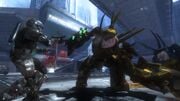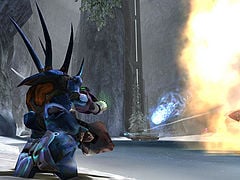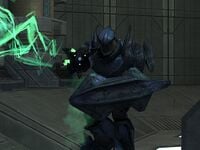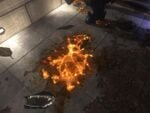Mgalekgolo
From Halopedia, the Halo wiki
Template:New Content Template:Covenant Species Infobox
- "They're all scary and angry and they like to smash things..."
- — Bungie
The Mgalekgolo[1] (Ophis congregatio, meaning "serpent union"[2]), more commonly known as Hunters, are a unique gestalt of smaller creatures known as Lekgolo, which are tiny, orange, worm-like creatures that group together to exponentially increase their intelligence, strength, and maneuverability. During and after the Great Schism there was a division within the species, some aligning with the Covenant Separatists and others remaining with the Covenant Loyalists. They always come in pairs or "bond brothers." The death of one will enrage the other if it witnesses the other's death.
Background
When the Mgalekgolo home world of Te was discovered by the Covenant, intent on mining its riches, they faced, instead, heavy resistance from what the humans know as "Hunters". Their physiology gave them a tremendous and unexpected advantage in combat, not only hampering, but even halting, the Covenant's advance and killing an Arbiter. The Covenant were further infuriated by the Lekgolo's destruction of Forerunner artifacts during the Mgalekgolo's routine feedings.[3] In ground combat campaigns they were mostly victorious, despite the valiant effort of the Sangheili. The Covenant was forced to rely on orbital bombardment, a strategy against which the Mgalekgolo had little to no defense. Thus, to save themselves from extinction, their only choice was to agree to join the Covenant. This later came to be known as the Taming of the Hunters. Terms for their induction into the Covenant were eventually met, despite communication difficulties (which hampered the process). In their agreement to join with the Covenant, the Lekgolo worms, which fed on specific minerals, were consigned to investigate the Forerunner Dreadnought that resided in High Charity and help uncover its inner workings. Their price for this trade was access to space-travel technologies and exploration of the Covenant space lanes.
When a single colony of Mgalekgolo becomes too big, the colony will divide in half to create two independent Mgalekgolo colonies. These colonies will share an extremely close and mysterious bond, referred to only as being "bond brothers", or "mates".[4] The armor and Assault Cannons used by the Mgalekgolo were given to them by the Sangheili after the former joined the Covenant. Mgalekgolo that have split into "bond brothers" are recognized by spiked appendages that rise from their shoulders, which means that they are bonded to another Mgalekgolo.[3] Bonded Mgalekgolo colonies are dropped into battle together by the Covenant, as the Spartans learned: where you find a Mgalekgolo, there is always another close by. If one of the bonded colonies is killed, the other will go into a frenzied state, much like the berserk state of a Jiralhanae, or the suicidal charge of an Unggoy. If left alone for a long period of time, however, they will adopt a "split personality" of shooting followed by melee attacks.
During the Battle of Onyx, some Mgalekgolos apparently had command of lower-ranking Sangheili, signifying they may have a higher military rank in the Covenant military than previously indicated.
Description
Hunters take the hulking bipedal form in the Covenant military.[5] In this form, they are the strongest and most resilient species in the Covenant [6]. They usually stand between twelve to thirteen feet tall, but when in their combat state they crouch into between eight to eight-and-one-half feet, protecting their visible, unarmored stomach and neck. Though uncommon, the Mgalekgolo can even come in larger sizes and even bigger than the standard Covenant Wraith. Their political motivation is completely unknown.[7] Their armor has a blue luster that makes the orange-red skin of the Lekgolo worms inside very noticeable, but the colony itself is hard to spot. They always fight in pairs due to the fact that when the colony gets too big, it splits into another Mgalekgolo form, creating a powerful bond between the two bond brothers.
Hunters fight using Assault Cannons integrated directly into their armor, and they carry an enormous, and nearly impervious metal shield made of an unknown alloy derived from the same material that forms Covenant warship hulls, and weighing approximately two tons. This shield protects them from almost every form of plasma-based or ballistic weaponry available to Covenant and human infantry alike, and is a powerful melee tool capable of crushing anything in its path and allowing the Mgalekgolo to sweep away most enemies in close combat. The Hunter can also gain a surprising burst of speed when it moves in for a melee kill.
The Assault Cannon the Hunter wields operates in two modes; one firing a single explosive capsule of incendiary fluid[8], the other spraying the fluid out like a beam.[9][10]
Anatomy and Physiology
- Main article: Lekgolo
Hunters are not a single organism, but rather are composed of multiple small, orange, eel-like beings called Lekgolo, that form a single collective consciousness and act as one, a single "hive-mind", similar to the structure of operation in the Flood. In other words they are a communal organism working together to perform specific tasks. Mgalekgolo are capable of manifesting in several different iterations according to what goal they are striving to achieve and the amount of Lekgolo worms that are present. The Mgalekgolo is the most common form seen in combat during the Human-Covenant War, but is actually one of the more rare forms in the Lekgolo society. This Mgalekgolo is employed by the Covenant as heavy infantry. Their society is predominated by this combination of being able to create exponentially more intelligent creatures, and the actual "Hunter" organism is one of the rarer and smaller forms to be found, used primarily in interaction with the Covenant hierarchy. Because of their make-up of several hundred "eels" instead of being a single large organism, the Lekgolo are one of the only species in the Covenant that cannot be assimilated by the Flood, as their unique physiology does not allow the organism to access a central nervous system or control them to any capacity. As such, there has never been a Hunter Combat Form, though the flesh of the Lekgolo can most likely be used by the Flood simply for its biomass.
The collection of eels that make up a Hunter's body are unintelligent at the most basic level, but can form complex thoughts and emerge as a conscious individual when they combine into larger masses that communicate through chemical and electrical means. The neural net that Hunters develop enables them to be incredibly strong and very sensitive to all things within a 1,000 foot line pointing out from non-combat form, and a half sphere that extends 500 feet in combat form[verification needed]. This could explain why Hunters sometimes can locate the Master Chief even when they cannot see him, or when they are facing the opposite direction. This also explains why Hunters can think and work as an effective combat unit without even using verbal communication. Hunters generally growl during battle but will sometimes talk and make remarks like the other Covenant species. Instead of using vocal chords, like other Covenant species, they vibrate their bodies to make a low rumble that is described as "more felt than heard" to produce speech.[11]
It is theorized that Hunters reproduce asexually similar to earthworms; however there is no way to be certain. If true, calling Hunter pairs "mates" would only make sense in term for the pairing of two, not actually mating.
Communication
Little is known about the Hunters' language. The known names of some Hunters seem to imply that they use very simple vowels, and few consonants—not nearly as many as are contained in the English alphabet. It is known that Hunters do not use vocal chords to speak; instead, they seem to vibrate the Lekgolo in their bodies to produce sound. Their quiet nature amongst other races of the Covenant results either from difficulty speaking with other Covenant races or difficulty tolerating other Covenant races.
Hunters' speech can be heard in all of the Halo games, and has changed very little during the course of the series. Hunters tend to make very deep, low rumbling noises when detecting enemies or when wounded. When dying, they seem to emit a low-pitched scream. They also seem to chuckle after a kill. Aside from that, Hunters barely talk. They are, however, capable of mimicking the language of other species via subsonic vibrations, forming words and sentences that are "felt" rather than "heard".[11][12]
Culture
Mgalekgolo almost never associate or even communicate with the other races in the Covenant Empire. Sangheili are the sole exception; Hunters appreciate and acknowledge the Elite warriors' thoughts and adeptness in combat. To the other races of the Covenant, however, the Hunters are dismissive, scornful, and arrogant, and they are utterly contemptuous of their foes. Hunters have no qualms about committing friendly fire against the "lesser" races, like Unggoy and Kig-yar; during the Battle of Sigma Octanus IV, a Hunter was seen running over and killing a Jackal. In Halo 3: ODST, Hunters will attack foes regardless of any allies that happen to be in their line of fire, as demonstrated in the game's final Campaign mission.
Many members of the Covenant are mystified and confused by the Mgalekgolo; their way of life is almost as alien to the Covenant as that of the Flood. A Sangheili Fleet Master once noted that Hunters were known to tear opponents apart with their "bare hands" whilst in a blood frenzy, and then suddenly pause to recite war poetry.[13] It has also been said that Hunters meditate in their spare time, or before battle.
During the Covenant Civil War, most Hunter pairs sided with the Sangheili and the Covenant Separatists, though others remained with the Prophet of Truth and the Covenant Loyalists. There is no known reason for the split in loyalty. It is likely that the Separatist Hunters split from the Covenant due to their respect for the Elites. It is likely that the Loyalist Hunters remained in the Covenant out of fear for their homeworld; the Hunters were integrated into the Covenant during the Taming of the Mgalekgolo, when the Covenant threatened to glass their homeworld.
No Hunters are ever seen supporting the Master Chief during the events of Halo 3. This is because in the making of Halo 3, Bungie did not want to confuse players by having them with both the Separatists and the Loyalists, so they were only shown as Loyalists.
Naming
Hunters have three names: a personal name, a bond name, and a line name. The personal name is given at their "birth". The line name represents the genetic heritage, being the name of the most successful Mgalekgolo of his ancestors. If one reaches a certain level of status, his offspring will have his personal name as their line name. The bond name, or their middle name, is taken between bonded pairs, colonies that must split into two due to excessive size. Examples of some Hunter names include Igido Nosa Hurru and Ogada Nosa Fasu. From the few Hunter names that have appeared in the novels, it seems that the given name has three syllables, but the bond name and line name only have two syllables. This may be another 7 reference, as 3 + 2 + 2 = 7.
However, it is not known why the line name is not three syllables, considering that the ancestor in question's given name would be three syllables. It is most likely not always three syllables or the name is edited (a syllable is possibly taken away) before the offspring is given the line name.
Religion
All that can be said for certain about Mgalekgolo religious beliefs is that they vary. While the Lekgolo joined the Covenant for its access to space trade routes and starships, rather than any real dedication to the Great Journey, at least some hold a concept of an "afterlife".[1][4] Other Lekgolo meditate in their spare time, or recite war poetry before or after battle, showing a more refined nature than would be believed of the hulking, savage warriors.[14] The fact that some allied themselves with the Sangheili during the Great Schism, while others remained with the Covenant Loyalists, is further evidence that individual beliefs play a major part in Mgalekgolo religion.[10] Anything further than this is speculation, Lekgolo culture is extremely reclusive, and even their fellow Covenant know little about them other than that they continue to follow their own cultural traditions, rather than the homogenized religion of the wider Covenant.[15]
Ranking System

Unlike other Covenant forces, Hunters seem to possess no visible rank. They are deployed as support troops rather than as baseline soldiers, which may therefore indicate that a rank is unnecessary as they are used as equipment rather than soldiers. They seem to be of a low rank, but are only seen under the command of Sangheili, Jiralhanae, or San 'Shyuum.
However, they can be deployed independently of other Covenant troops, which may indicate that a level of independence and responsibility may be granted, thus meaning that they may have a high enough rank to be trusted by themselves. In Halo: The Fall of Reach, Mgalekgolo are seen guarding the crystal in Cote d'Azur, which is retrieved by Blue Team. As they are guarding such a highly valued target, they may be of a higher rank than other Hunter pairs. Also they killed a Jackal by stepping on it, which may show that they are higher in rank than the Jackals, although it is more likely that the Hunters merely did not care about the other alien's life. [16]
In Halo 3: ODST, the Hunters appear in two different forms in two different colors; the normal blue-armored Hunter, which are identical to the ones seen in Halo 3, armed with an Assault Cannon that fires a continuous stream of radioactive incendiary gel and a gold-armored Hunter, armed with an assault cannon that fires a single bolt of radioactive incendiary gel which is similar to the weapon model featured in Halo: Combat Evolved. Gold-armored Hunters were said by Bungie to be leader Hunters.Template:Fact
In addition, in Halo: Contact Harvest, a third rank of Hunters with silver clad armour is said to be guarding the Forerunner Dreadnought in High Charity.Template:Fact
Trivia
- In Halo 2 it is impossible to kill or even damage a Hunter with any melee attack.
- In Halo: The Flood, it mentions that Hunters have skin and a jutting spine. This is incorrect, as they were revealed to be a compound of small worm-like creatures. However, this does not preclude the possibility that the worms may form a skin-like membrane on the outside of their colony for protection against more casual damage, and in Halo 3 a metal column can be seen after the back armor plating has been detached, perhaps forming an artificial "spine" for vertical support.
- At first, Hunters were meant to comprise the whole of Heretic forces on the Gas Mine.[17]
- In a Bungie Weekly Update, Frank O'Connor said: "Hunter society is complex and we have seen but the tiniest fraction of it. There are some fundamental facts about Hunter biology that mean the combat type is just the tip of the iceberg."[18] This means, or at least implies, that there are other kinds of Hunters that simply have yet to be seen. For example, Scarabs are powered by these worms.
- SPARTAN-II William-043 killed a Hunter by ripping out some of the Lekgolo worms in its body, showing that a Hunter can be killed if too many of its worms are displaced.
- It is possible to splatter a Hunter with a Mongoose.
- In Halo Wars, a Hunter can deflect many projectiles that would kill them in Halo 3, for example a Wraith Mortar or a Scorpion main cannon shot.
- The Hunter resembles the enemy of the same name from Bungie's older series, Marathon, except that Marathon's Hunter has a shoulder-mounted weapon, rather than an arm-mounted weapon.
- Hunters can range in size from a Spartan to nearly eighteen feet tall.
- Hunters in Halo: Combat Evolved are not harmed by Fuel Rod Guns. This may be because you are not supposed to have Fuel Rod cannons in Campaign, or it may be a precaution meant to prevent Hunters from injuring each other when fighting in pairs.
- Hunters in Halo: Combat Evolved have ranks in the actor variant tags. One variant is called 'Hunter' and another called 'Hunter major'. In Halo 2, there is no ranking system for Hunters.
- Like most other races of the Covenant, Hunters' blood differs from that of humans. Mgalekgolo blood is bright, fluorescent orange and appears to have a very thick, slimy texture. It has also been noted that their blood smells strongly of burnt plastic, hinting that the make-up of their bodily fluids is drastically different from that of a human.
- In Halo: First Strike, it was stated that the spikes on the Hunter's back are sensory nodes.[19] Additionally, the spikes on Hunters' backs were said to be as sharp as razors in Halo: The Flood.
- In Halo Legends' episode The Duel, the Hunters are shown to be at least 50 feet tall, this was later explained by Frank O'Connor saying that a Hunter's appearance changes due to the gravity and environment.
- In Halo Reach hunters have received a huge graphical overhaul. They are much more textured, appear to be larger,have Forerunner symbols and emblems on their armour and appear to have some kind of eyes on their helmets.
- In Halo: Combat Evolved, a single shot from a pistol or sniper rifle will kill a Hunter; this is likely because the Hunter's exposed flesh was considered to be its "head."
- In Halo: Reach, the ranks of Hunters in Firefight are as the following: Hunter Kill Team, Hunter Strike Team, Hunter Tactical, Hunter Infantry, Hunter Patrol, and regular Hunter. [20]
- In Halo: Reach Hunters are smarter then they were in the previous games, as they will use their shield to protect themselves.
- In Halo: Reach it is said that spartans may be able to wield Assault Cannons. [21]
- When combatting Hunters, a player can 'leapfrog' the charging melee attack, either jumping above or to the side of the hunter. This exposes the rear armor to a quick shotgun blast or grenade stick, often resulting in death on lower difficulties. This tactic does not work as well on Halo 3: ODST, however, as the Hunter's melee swing usually knocks the player away and to the front, not behind.
- Hunters are better when bonded ,as seen in Halo Wars, one of their upgrades is to fight stronger when bonded with their bonded pair.
Gallery
- Cov Hunter.jpg
Concept art of a Hunter for Halo Wars.
The Hunters as they appear in the Halo Legends episode, The Duel.
- Fuel Rod Beam Cannon in Action.jpg
A Hunter firing its Assault Cannon.
- Gold Hunter.png
A pair of gold Mgalekgolo in Halo 3: ODST.
- Halo Reach - A Spartan Will Rise.jpg
A group of Hunters ready to attack in Halo: Reach.
Sources
- ^ a b Bestiarum
- ^ HBO Forums
- ^ a b Halo: Contact Harvest
- ^ a b Halo: The Flood
- ^ Bestiarum
- ^ Halo 3 Game Guide, http://www.microsoft.com/silverlight/halo3.aspx, On Covenant character page.
- ^ Halo Legends: The Duel
- ^ Halo: Combat Evolved
- ^ Halo 2
- ^ a b Halo 3
- ^ a b Halo: Ghosts of Onyx, pages 190-191
- ^ Halo 3: ODST Field Guide
- ^ Ghosts of Onyx
- ^ Halo: Ghosts of Onyx
- ^ The Covenant Primer: Best of The Bestiary
- ^ Halo: The Fall of Reach page 222
- ^ "Essentials - Disk Three"
- ^ http://www.bungie.net/News/TopStory.aspx?story=updatefeb03
- ^ Halo: First Strike, page 110
- ^ Bungie weekly update 6/18/10
- ^ http://www.computerandvideogames.com/article.php?id=261713









